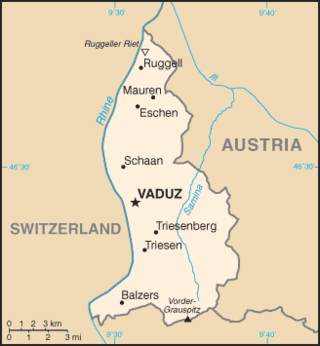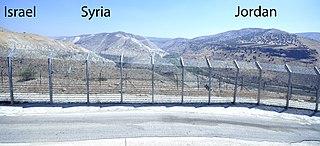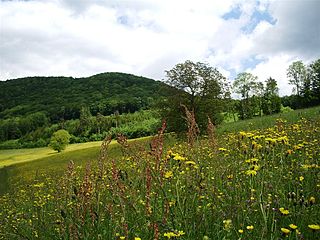
The principality of Liechtenstein encompasses most of the eastern half of the Rhine Valley, wedged between Austria and Switzerland. The majority of the country's population is found in the western half along the Rhine River. Along with Uzbekistan, Liechtenstein is one of only two doubly landlocked countries in the world.

The Four Corners Monument marks the quadripoint in the Southwestern United States where the states of Arizona, Colorado, New Mexico, and Utah meet. It is the only point in the United States shared by four states, leading to the area being named the Four Corners region. The monument also marks the boundary between two semi-autonomous Native American governments, the Navajo Nation, which maintains the monument as a tourist attraction, and the Ute Mountain Ute Tribe Reservation.

Austria is a predominantly mountainous country in Central Europe, approximately between Germany, Italy and Hungary. It has a total area of 83,871 square kilometres (32,383 sq mi), about 2.031706 times the size of Switzerland.

The Mason–Dixon line, also called the Mason and Dixon line or Mason's and Dixon's line, is a demarcation line separating four U.S. states, forming part of the borders of Pennsylvania, Maryland, Delaware, and West Virginia. It was surveyed between 1763 and 1767 by Charles Mason and Jeremiah Dixon as part of the resolution of a border dispute involving Maryland, Pennsylvania, and Delaware in the colonial United States. The dispute had its origins almost a century earlier in the somewhat confusing proprietary grants by King Charles I to Lord Baltimore (Maryland), and by his son King Charles II to William Penn.

The Karawanks or Karavankas or Karavanks are a mountain range of the Southern Limestone Alps on the border between Slovenia to the south and Austria to the north. With a total length of 120 kilometres (75 mi) in an east–west direction, the Karawanks chain is one of the longest ranges in Europe. It is traversed by important trade routes and has a great tourist significance. Geographically and geologically, it is divided into the higher Western Karawanks and the lower-lying Eastern Karawanks. It is traversed by the Periadriatic Seam, separating the Apulian tectonic plate from the Eurasian Plate.

A tripoint, trijunction, triple point, or tri-border area is a geographical point at which the boundaries of three countries or subnational entities meet. There are 175 international tripoints as of 2020. Nearly half are situated in rivers, lakes or seas. On dry land, the exact tripoints may be indicated by markers or pillars, and occasionally by larger monuments.

The Little Hungarian Plain or Little Alföld is a plain of approximately 8,000 km² in northwestern Hungary, south-western Slovakia, and eastern Austria. It is a part of the Pannonian plain which covers most parts of Hungary.

Southern Germany is a region of Germany that included the areas in which Upper German dialects are spoken, which includes the stem duchies of Bavaria and Swabia.
A quadripoint is a point on Earth where four distinct political territories meet. The territories can be of different types, such as national and provincial. In North America, several such places are commonly known as Four Corners. Several examples exist throughout the world that use other names.

A boundary marker, border marker, boundary stone, or border stone is a robust physical marker that identifies the start of a land boundary or the change in a boundary, especially a change in direction of a boundary. There are several other types of named border markers, known as boundary trees, pillars, monuments, obelisks, and corners. Border markers can also be markers through which a border line runs in a straight line to determine that border. They can also be the markers from which a border marker has been fixed.

The Chiemgau Alps are a mountain range in the Northern Limestone Alps and belong to the Eastern Alps. Their major part is situated in Bavaria, Germany and only a small section crosses the Austrian border into the states of Salzburg and Tirol. They reach their highest elevation (1961 m) in the Sonntagshorn, a peak straddling the German-Austrian border.

Schinder is a mountain on the border of Bavaria, Germany and Tyrol, Austria. There are two summits, one called Austrian Schinder or Trausnitzberg, and the other slightly lower one called Bavarian Schinder. The former sits right on the border of Bavaria and Tyrol, whereas the latter is situated wholly in Bavaria.

Sorgschrofen is a 1,635-metre-tall (5,364 ft) mountain in the Allgäu Alps of Bavaria, Germany. A lower summit of Sorgschrofen is the 1,613-metre-tall (5,292 ft) Zinken. There is a summit cross on both Sorgschrofen and Zinken.

The geographic center of the United States is a point approximately 20 mi (32 km) north of Belle Fourche, South Dakota at 44°58′2.07622″N103°46′17.60283″W. It has been regarded as such by the U.S. National Geodetic Survey (NGS) since the additions of Alaska and Hawaii to the United States in 1959.
The Tannheim Mountains are a sub-group of the Allgäu Alps in the Bavarian-Tyrolean border region. Their name is derived from the village of Tannheim in the Tannheim Valley in the Austrian state of Tyrol.

The Randen is a small mountain range located between the Jura and the Swabian Jura, north of the Rhine. Predominantly located in the Swiss canton of Schaffhausen, they culminate in the German state of Baden-Württemberg. The Randen, which belong to the Table Jura (Tafeljura), are situated north of Schaffhausen and south of Blumberg.

The border between the modern states of Germany and Switzerland extends to 362 kilometres (225 mi), mostly following the High Rhine between Lake Constance and Basel.

The Austria–Germany border has a length of 815.9 km (507.0 mi) or 815.0 km (506.4 mi) in the south of Germany and the north of Austria in central Europe. It is the longest border of both Austria and Germany with another country.




















